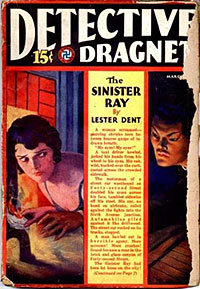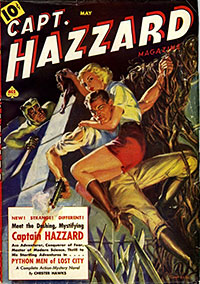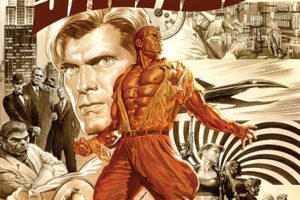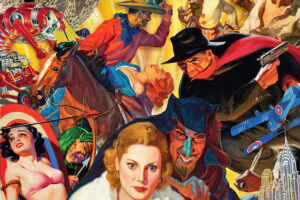
In the next in this series of articles, I take an overview of one of the major pulp publishers and their pulp heroes: Ace Magazines.
Established in 1928 by Harold Hersey as Magazine Publishers, the company was taken over by A.A. Wyn in 1929. Keeping the name, the line was labeled Ace Magazines and used an ace of spades as a logo. Periodical House was another company name used, so the line might be referred to as Magazine Publishers, Periodical House or Ace.
In 1940, Wyn branched out into comic books with Ace Comics. In 1952, Ace Books was formed, which focused on paperbacks. Like other publishers, in 1956 the pulps and comics were dumped, and he focused on Ace Books, which soon became a major genre publisher of science fiction.
Ace published several pulp heroes, many in their long-running magazine Ten Detective Aces (originally called Dragnet then Detective-Dragnet), others in their Flying Aces.
Among their heroes were:
• Wade Hammond (1931-36) was created by Paul Chadwick, and appeared in Ten Detective Aces (at that time Detective-Dragnet). This long running hard-boiled detective was different in that he faces science fictional and weird menace threats. All his stories have been reprinted in 4 volumes by Off-Trail Publications.
• Philip Strange (1931-39): In Ace’s Flying Aces magazine, the first of several aviation pulp heroes began with Donald Keyhoe‘s Philip Strange series. He lasted 64 stories until 1939. Phil Strange was a mental marvel who fought a bizarre version of WWI. Some say this character and his adventures was the inspiration for G-8 and his adventures, and is supposedly better written. Age of Aces is reprinting his stories, with two collections out and a third announced.
 • Lynn Lash (1932): Lester Dent did two stories of his first “gadget hero,” Lynn Lash, 1932. These appeared in Detective-Dragnet. It is supposedly these stories that helped get him Doc Savage to create and write. The stories have been reprinted by Altus Press.
• Lynn Lash (1932): Lester Dent did two stories of his first “gadget hero,” Lynn Lash, 1932. These appeared in Detective-Dragnet. It is supposedly these stories that helped get him Doc Savage to create and write. The stories have been reprinted by Altus Press.
• Moon Man (1933-37) was also a long-running series in Ten Detective Aces, getting 39 stories, the same as Wade Hammond. Created by Frederick Davis, this Robin Hood-like character stole from the corrupt rich to give to the poor of Great City. Sadly, the original stories are only available in an expensive set of reprint books. He has been used in several new stories in recent years.
• Blonde Adder (1933): The second of Lester Dent’s “gadget heroes,” Lee Nace the Blonde Adder, ran five stories in, yes, Ten Detective Aces. Dent started this character shortly after starting Doc Savage, but soon stopped. The whole run has been reprinted by Altus Press. See my prior posting on him.
• Cobra (1934) was a snake-themed pulp hero who appeared in, wait for it, Ten Detective Aces for just three stories. He has been reprinted in a volume by Altus Press, with some additional works by his creator, Richard Sale. A review on him is coming soon.
• Secret Agent X (1934-39) may be the most well known of Ace’s heroes. Created by Paul Chadwick, later handled by others including G.T. Fleming-Roberts, this secret agent crime fighter was a mixture of elements of both Doc Savage and The Shadow. He lasted 41 issues in his own magazine. Altus Press is reprinting the originals in a series of omnibus volumes (six so far of a planned nine), and put out a companion book. Others have put out new SAX stories and novels, including Airship 27 and others.
• Mark Hazzard (1935-36): Frederick Davis, who wrote the Moon Man series, also did a couple of short backup series in Secret Agent X. First was Mark Hazzard for six stories in 1935-36. Almost a clone of the Moon Man, Hazzard was a crusading district attorney, who was also a wanted fugitive. So he always had to worry about being exposed, just like the Moon Man did. There has been no collection of this series.
• Ravenwood (1936): The second was the more interesting Ravenwood for five stories in 1936. An occult detective, Ravenwood was a rich playboy who was raised in the occult knowledge of Tibet (shades of the Green Lama and others). He has been reprinted by Altus Press, with new stories from Airship 27. See my posting on him.
• The Griffon (1935-42): At the same time, some additional long-running heroes were added to Flying Aces, both set in modern times. First off is the Griffon. An agent of the Justice Department, he flew a special amphibious craft and fought crime wearing a scarlet mask.
• Richard Knight (1936-42): And then Donald Keyhoe’s Richard Knight, blinded but now able to see in the dark. He now operates as “Q”, a freelance secret agent, fighting evil and having adventures similar to Keyhoe’s Philip Strange. Altus Press is reprinting both of these characters, with Pro Se Press putting out new story collections in their Pulp Obscura line.
 • Captain Hazzard (1938): An obvious Doc Savage clone, Captain Hazzard lasted but one story of his own magazine, but has lived on. In particular, Ron Fortier of Airship 27 has taken on the character with new stories.
• Captain Hazzard (1938): An obvious Doc Savage clone, Captain Hazzard lasted but one story of his own magazine, but has lived on. In particular, Ron Fortier of Airship 27 has taken on the character with new stories.
Comic Books
As noted, Ace Magazines also had a comic book line, and some of their characters made the transition to comic books. But what is interesting (or strange) is that all of them appeared under different names!
The Moon Man was changed to The Raven, with all the other characters renamed. He ran for several stories.
Secret Agent X was renamed X The Phantom Fed. Five stories appeared, all based on original novels.
And the strangest change was with Captain Hazzard. While their origins were totally different, the plot of the only published Captain Hazzard story was used as the plot of the first Flash Lightning story.
Most of the Ace heroes have been reprinted, if not in inexpensive editions, and several have been used in new stories. So it’s easy to check them out. Do so; many are very interesting.



